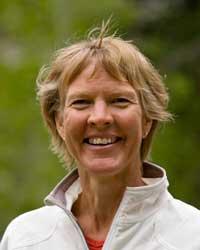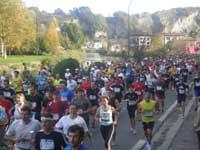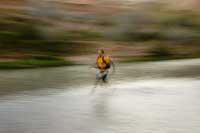Corridor that is forgotten

Being a young child of sixteen months, he suffered a brain injury that went unnoticed. The consequences appeared at the age of thirty, in the third pregnancy. He began suffering epileptic seizures, four or five per week. After a medical career, and after many laps, Diane Van Deren proposed to cut the root problem and take the hope. In this way, part of the temporal lobe of the left brain was removed. The crises disappeared, but not only. Some of the necessary capacities in everyday life also disappeared.
Since the intervention has no orientation capacity, it costs a lot to memorize things, it is difficult to organize tasks and has lost much of its capacity for spatial and temporal appropriation. The lack of awareness of space and time runs anywhere, but also the ability to run like no one.

Space and time
Space and time, regardless of culture, are perceived in a similar way by all human beings. This is explained by psychiatric professor Julio Vallejo Ruiloba in his book Introduction to psychopathology and psychology: "The perception of space and time is not uniform in all human beings. However, there are elements that in the human being have no variation in the perception of space, time, shapes and colors. For example, the orientation to the body is universal and its proper functioning depends on certain areas of the brain."
While living, man fills space and eats time. All human activities are linked to these two parameters. Of course, when the functioning of the brain is correct. In the case of Diane, his neurophysiologist, Don Greber, has stated in the New York Times that he does not become aware of the time that passes or the space he occupies "helps him when he runs, because he does not worry about the distance of the goal, but does not help him in anything else."

Thanks to his own physical capacity and illness, the U.S. athlete won the Arctic ultramarathon of Yukon, a race of 688 kilometers in snow every two years.
To be the best in the world, train hours and hours in the Colorado Rocky Mountains without knowing the limits of time and space perception. Having all the kilometers traveled in the head or not being able to skim what is missing to reach the goal is a great barrier for athletes, which increases the feeling of muscle fatigue.
Fatigue is a weakness caused by excessive activity, but also a subjective feeling of lack of energy. The head is a great enemy for those who perform physical effort. Even outside Elite, when we run, each uses his tricks to forget: enjoy the landscape, talk with his friend, listen to music, work concentration… But Dian doesn't need it. According to Greber, "it can run hours and hours without remembering the time it has run." Yes, if they don't know it for twenty-four hours, the family members have the order to ask for help.
Published in Ortzadar
Buletina
Bidali zure helbide elektronikoa eta jaso asteroko buletina zure sarrera-ontzian











